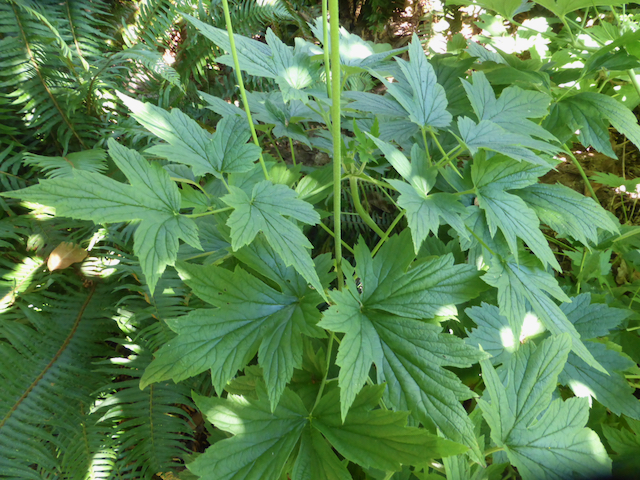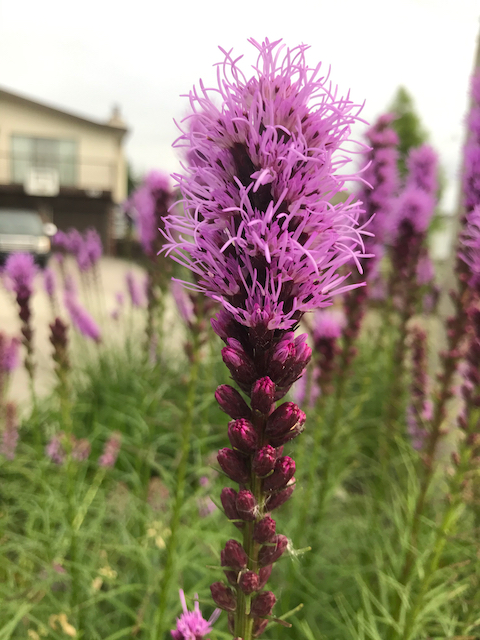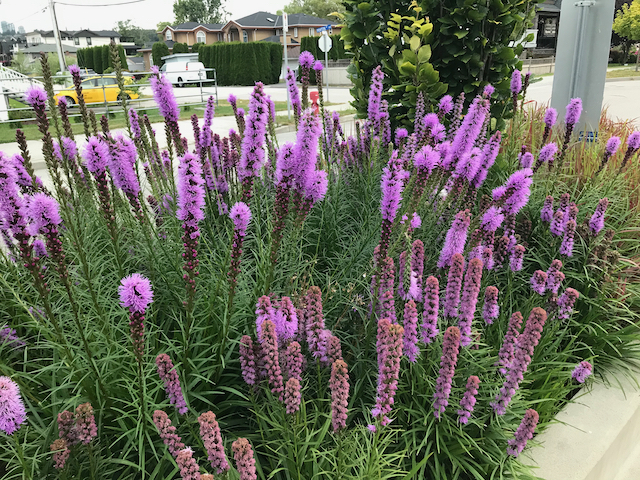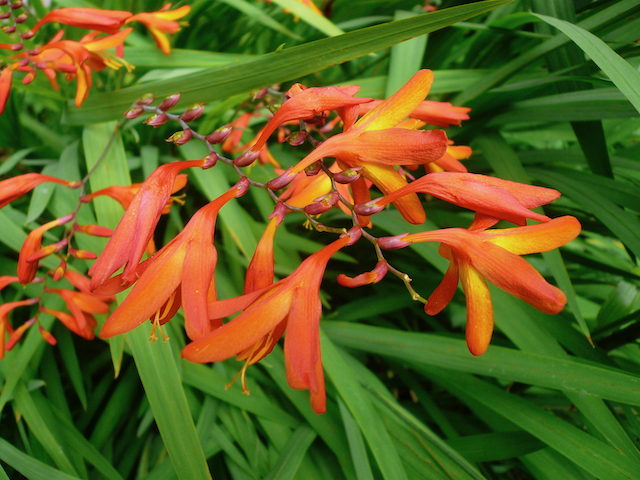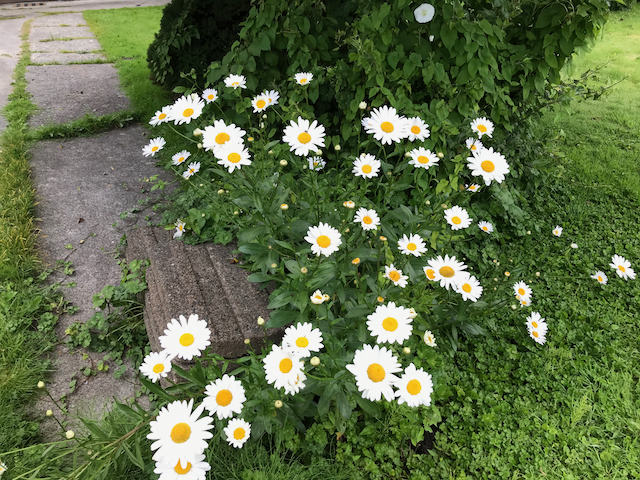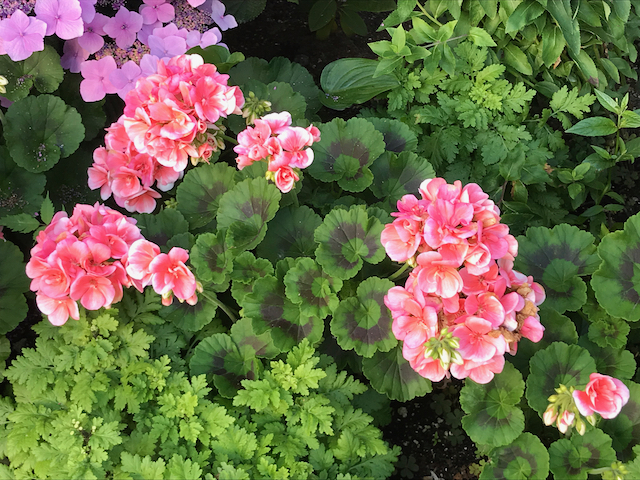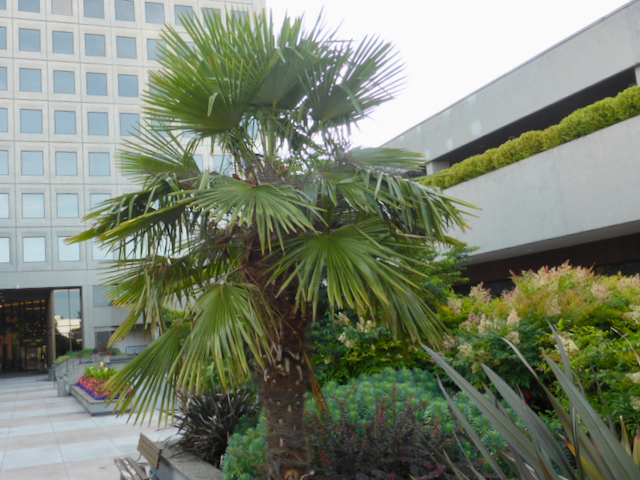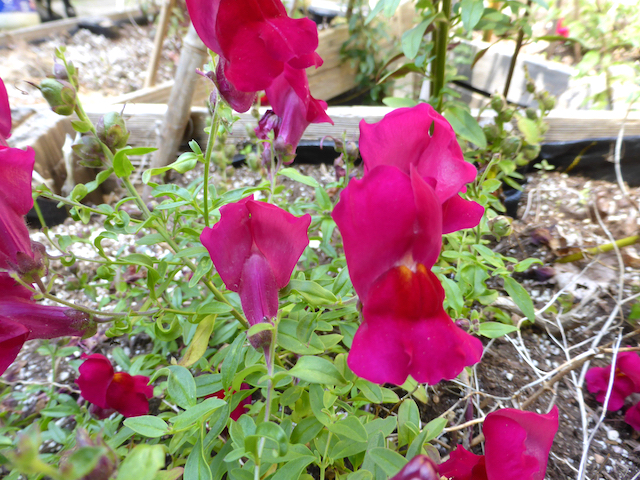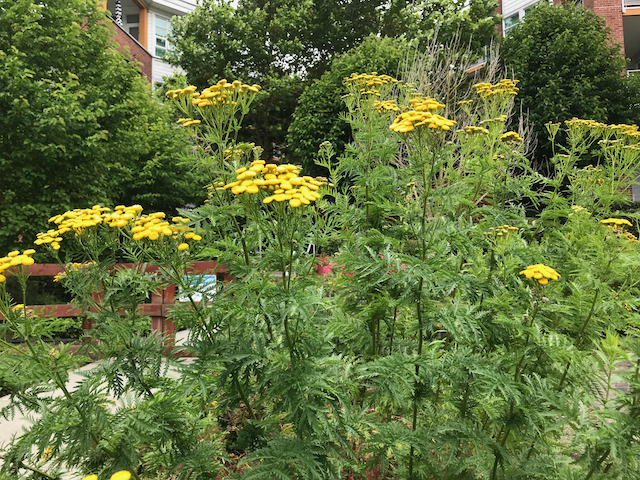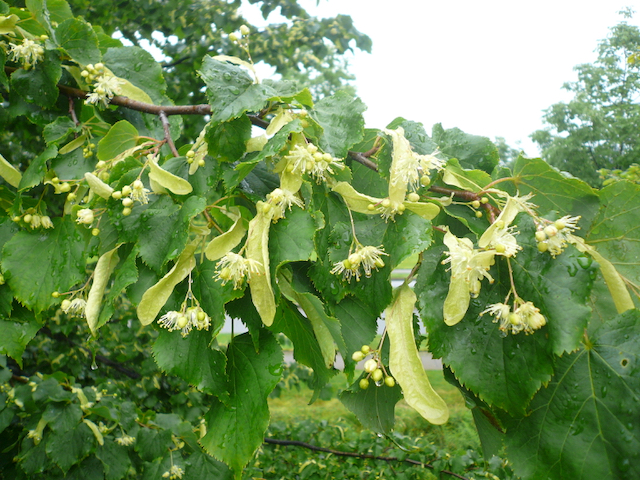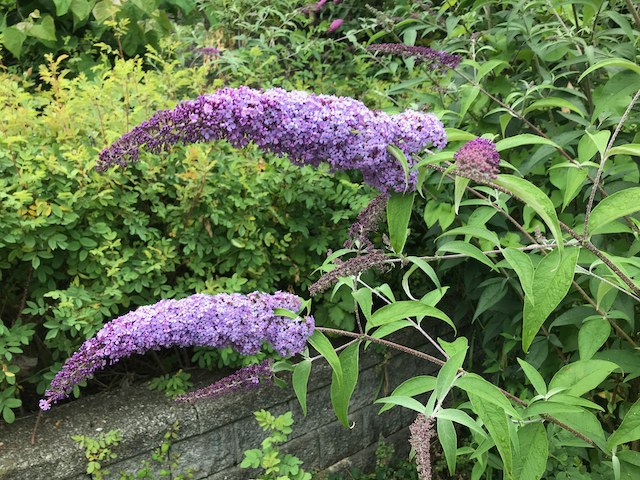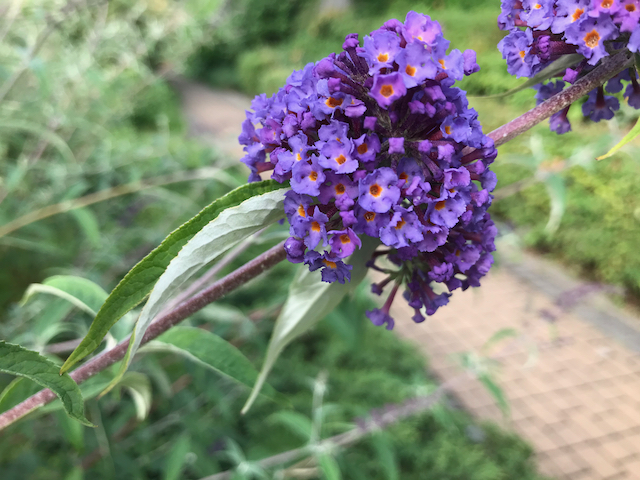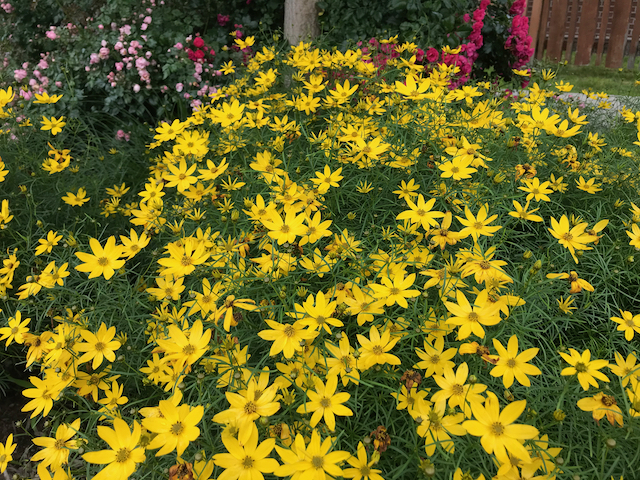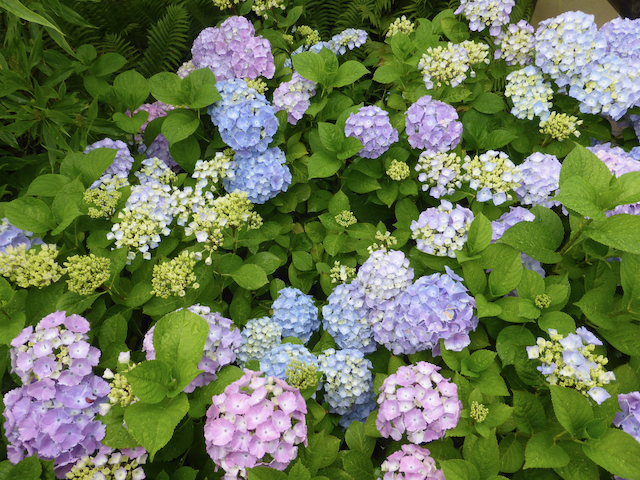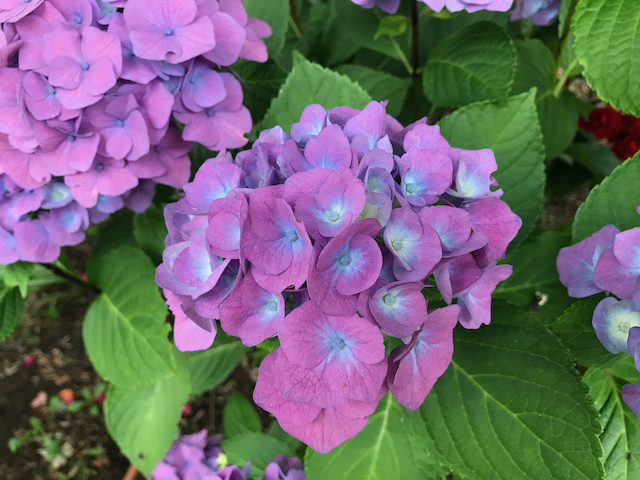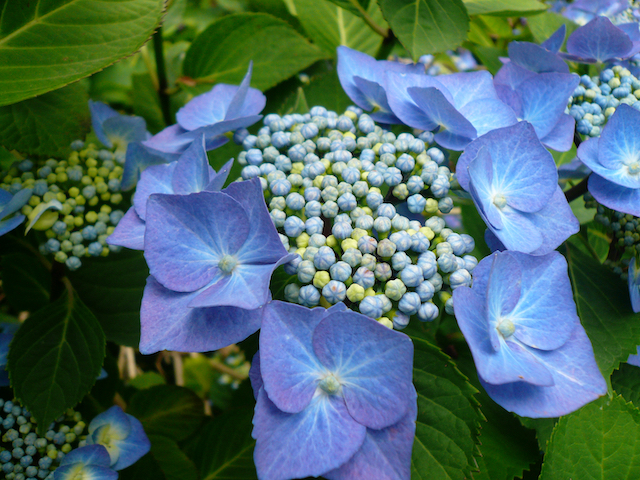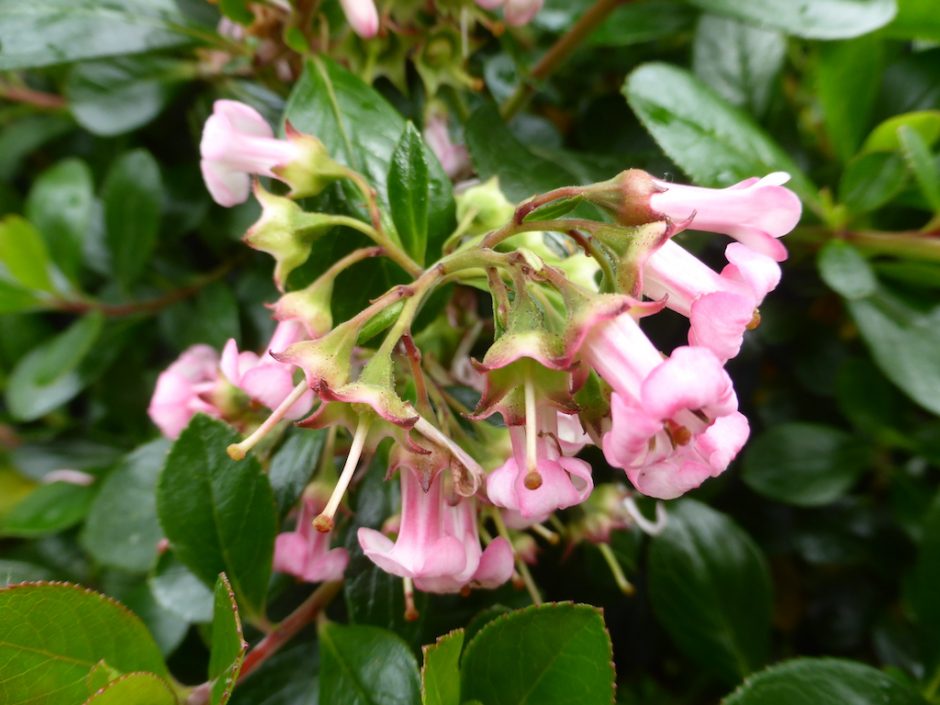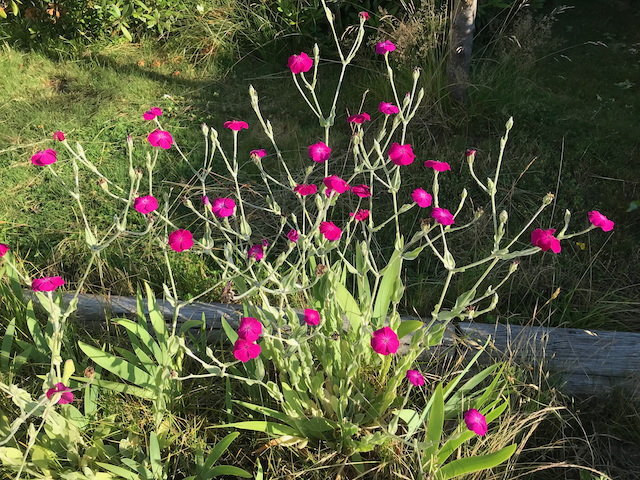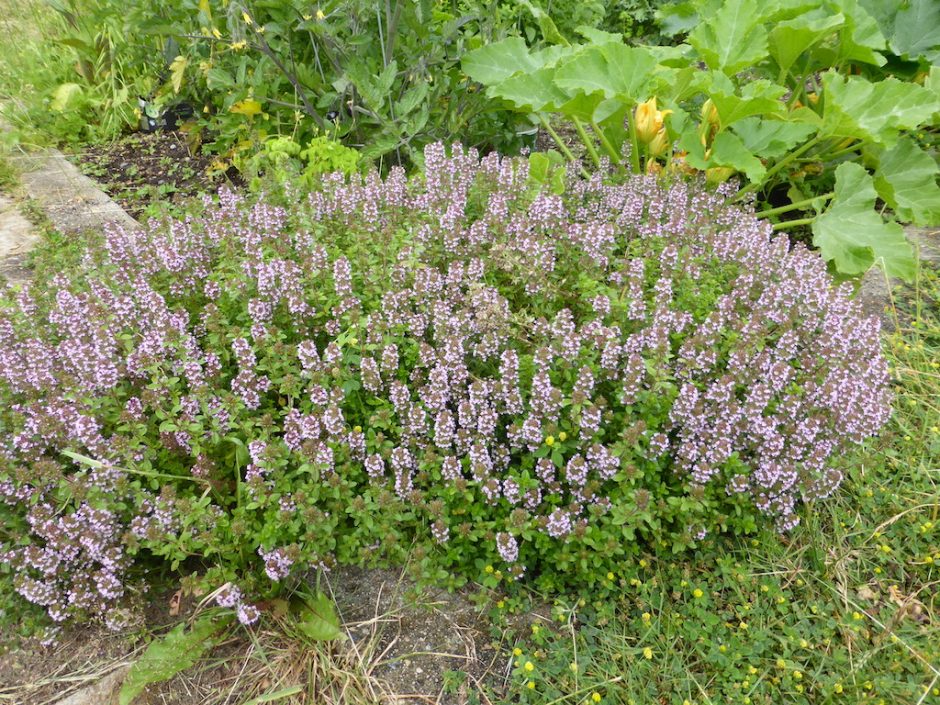July 27-August 2
Anemone hupehensis (Japanese anemone, wind flower)
This long blooming perennial is a favourite for summer and early autumn displays. There is often some confusion regarding the correct names for these commonly cultivated anemones. To start, they are not Japanese, but Chinese. The name “hupehensis” means coming from Hupeh (now spelled Hubei), a Province in China. Many of the cultivated selections are hybrids—A. x hybrida being a mixture of two similar-looking Chinese species, one of them A. hupehensis. Regardless, they all conform to a basic design: multiple stems arising from a network of woody, running roots; basal leaves that consist of coarsely three- to five-lobed leaves or three coarsely lobed leaflets, on often very long petioles (leaf stems); and multi-branched flower stalks that rise high above the foliage.
Despite the similarities of the various species (they are notoriously difficult to differentiate and are often classified separately by the length of hairs they display), there is a wide range in plant height, leaf size, flower colour and time of flowering. The stems are stiffly upright, but in the shade, flop over by the time flowers begin opening. The flower stalks produce similar-looking but short-stalked and progressively smaller leaves at each set of branches up the stem. The flowers are typically saucer-shaped, 5 to 7 cm in diameter, with four to six petaloid, white or pink to rose purple sepals (flowers in the buttercup family are always apetalous), and with a rounded mass of golden stamens at the centre. The backs of the sepals are nearly always darker than the facing side.
Catalpa (catalpa, bean tree)
Catalpa is a genus of about a dozen species of deciduous trees native to East Asia, eastern North America and the Caribbean. The two eastern American species, C. bignonioides (southern catalpa) and C. speciosa (northern catalpa), are occasionally cultivated in Vancouver. Catalpa bignonioides is the most common species locally. Trees can grow 20 m tall, but usually have a low, broad, irregular crown that is as wide as it is tall, composed of a few massive, twisted branches from a short, crooked trunk. On older specimens the bark is usually orange-brown and scaly, exfoliating in patches and exposing lighter under-bark. The huge, wavy-margined, heart-shaped leaves are between 20 and 30 cm long and 15 to 20 cm wide. They are borne oppositely or in whorls of three on the shoots. Flowers are produced in the summer, usually not before July. They are about 3 or 4 cm wide, white, marked with yellow streaks and purple blotches, and borne in conical, 15- to 25-cm tall, purple-stemmed clusters of between twenty and forty at the tips of the branches. Slender, bean-like fruits up to 50 cm long appear soon after. Catalpa speciosa is similar and equally common in street and park plantings, but taller and with more furrowed bark.
In Vancouver, catalpas are notably late to leaf out; bud break is usually in late May or early June and trees typically lose their leaves well before the end of October. Two C. bignonioides cultivars are seen in residential gardens. ‘Aurea’ has pale yellow leaves and decidedly unhurried growth, while ‘Nana’ (umbrella catalpa) displays congested branching and half-sized leaves. In Europe, umbrella catalpa is sometimes touted as an ideal small residential tree for its mosquito-repelling attributes.
The derivation of the name catalpa is currently debated. Traditionally, it was thought that it was named for the Catawba Indian Nation, who inhabited territory in the American southeast, where C. bignonioides is native. However, the current thinking is that the name may be derived from the Muscogee word kutuhlpa, which evidently means “winged head,” presumably in reference to the winged seeds. The Muscogee Indian Nation, also original inhabitants of the American south (but one of the tribes forcibly removed to reservations in Oklahoma) was also located within the geographical range of southern catalpa.
The tongue-twister bignonioides refers to the similarity of the tree’s fruits to those of the subtropical Bignonia (bignoni = bignonia + oides = like), named for the French writer, statesman and preacher (and librarian to Louis XIV) Jean-Paul Bignon (1662-1743).
Lavatera x clementii (rose mallow)
Lavatera is a genus of about a dozen species of evergreen and deciduous herbs, subshrubs and shrubs native to the Mediterranean region, East and Central Asia, Africa and Australia. Stems are usually erect with alternately arranged, lobed leaves. In most species, flowers are produced on leafy unbranched stalks at the tips of the branches. The characteristic mallow flower is trumpet-shaped with rose-pink, purple or white petals. At the centre there is a staminal column—a club-shaped structure where all of the stamens are fused together—topped by a multi-branched stigma. The stigma is the pollen-receptive surface that terminates an elongated style, through which cells from the pollen pass to reach the ovary (thus affecting fertilization and seed production). Style branches at the top of the staminal column equal the number of chambers in the ovary.
Like in other mallows, the fruit is doughnut-shaped and splits into numerous wafer-like segments, each containing a single-seed. The mallow family includes cultivated plants that are familiar to many people, including Abelmoschus (okra), Abutilon (flowering maple), Alcea (hollyhock), Althaea (marshmallow plant), Alyogyne (lilac hibiscus), Callirhoe (poppy mallow) and Hibiscus, and these all follow much the same floral and fruit design.
The majority of woody lavateras cultivated in gardens are Lavatera x clementii—hybrid of the cold-hardy, herbaceous L. thuringiaca and the woody but frost-tender, L. olbia. Lavatera x clementii is a subshrub; that is, a woody-based shrub with herbaceous shoots. The woody portions of lavateras sometimes die back to the ground in Vancouver, especially in exceptionally cold and wet winters, but when well-sited, they can grow into sizeable plants. Most L. x clementii cultivars have more or less softly hairy, palmately-lobed leaves. They grow 1 to 2 m tall with 5-cm-wide white, pink or rose-purple flowers that are produced more or less continuously at the tips of the shoots throughout the summer. The flowers vary from cultivar to cultivar, but the petals are mostly broad with dark veining.
The genus is named for the brothers Lavater, 18th century Swiss naturalists. ‘Barnsley’ is probably the most celebrated rose mallow cultivar in gardens, but ‘Rosea’ is the most common. Plants of both cultivars grow to about 2 m tall with slender, sparingly-branched, purple-flushed shoots. The flowers of ‘Barnsley’ have satiny white petals, pink at the base, that age to pale pink overall, while those of the vigorous ‘Rosea’ are more uniformly mauve pink. ‘Barnsley’ originated as a branch sport (a mutation) of ‘Rosea’ at Barnsley House, the home and garden of the famous English garden designer, Rosemary Very (1918-2001). We seldom actually see the cultivar ‘Barnsley’, however, as the mutation is unstable and plants regularly revert back to the original ‘Rosea’.
Liatris spicata (blazing star, gay feather)
Native to eastern North America east of the Mississippi River, including in southern Ontario, L. spicata is the most popular of the Liatris species for gardens on account of its club-shaped stems and showy displays of pink to purple-blue flowers. Plants are clump-forming, growing from corms (starch-filled annual underground storage organs). The stiff, upright stems can be 1 to 1.5 m tall in the wild, but most cultivated selections are less than a metre tall. Leaves are long and narrow, up to 25 cm long at the base and quickly diminishing up the stems.
Like other members of the sunflower family, multiple flowers are borne on congested heads. In Liatris, the individual heads are stemless, have no rays (i.e., they don’t look like daisy flowers) and are only a few millimetres across. The flower heads are produced by the score on a club-like spike that sits atop the leafy stem. The first flowers to open are at the top of the spike, the lower flowers progressing quickly downward before those above them start to wither. As spectacular as the flowers are when open, the spent flower stalks can be a bit of an eyesore. They can be cut back, but they will not re-flower in the same year.
Lobelia cardinalis (cardinal flower)
Few perennials have flowers as intensely red as those of L. cardinalis. The species is native across eastern North America, from the Maritimes south and east to Texas, where it grows in moisture-retentive, fertile soil in semi-shaded conditions. In Vancouver, survival depends on summer irrigation and soil to which plenty of organic matter has been added. Plants can grow 60 to 120 cm tall with multiple upright stems, and narrow, toothed leaves up to 10 cm long.
The shape of the flower is unusual, as its five petals have been modified to attract hummingbirds. There are three lower petals that hang downward, while the two upper petals are fused together into a cowl which acts to protect the stamens and style (male and female parts) that project forward from the face of the flower. The two narrow petals to the sides of the cowl are anatomically part of the cowl structure. There is a nectary at the centre of the flower, into which the hummingbird dips her/his tongue. The pollen-producing anthers (at the tip of the stamens) and the pollen-receptive stigma (at the tip of the style) hang out from the cowl when they are ready to discharge or accept pollen. When the hummingbird dips in for the nectar she/he inevitably brushes her/his head on the ripe anthers or stigma, and pollination is assured.
In local gardens, most cardinal flowers are now hybrid cardinal flowers. Lobelia x speciosa is the name given to plants derived from crosses between L. cardinalis, L. splendens (a Mexican species with bronzy leaves and larger red flowers) and L. siphilitica (big blue lobelia). Hybrid plants are generally more garden adaptable with larger flowers in a wider range of colours.
July 20-26
Crocosmia ‘Lucifer’ (Lucifer montbretia)
The montbretias are a group of southern and eastern African iris relatives that produce highly coloured, mostly bird-pollinated flowers. The most common montbretia locally, Crocosmia x crocosmiiflora, is a variable, weedy species that pops up in older gardens. Like other iris relatives, montbretias produce more or less two-dimensional fans of foliage, with flower stalks that arise from the centre of the fan. The leaf arrangement, known as equitant, is common to nearly all iris relatives.
Montbretias are cormous plants; that is, they grow from an underground storage organ known as a corm. Corms are sometimes confused with bulbs as they serve essentially the same function, allowing plants to survive periods of drought or cold. However, corms are annual structures consisting of modified stem tissues, while bulbs are perennial and comprised of unexpanded overlapping leaves—picture an onion or lily bulb. In sun-warmed, well-drained soil, the corms of montbretia can proliferate, producing extensive colonies of sword-shaped leaves.
‘Lucifer’ is a particularly vigorous selection of this hybrid. It easily grows to 1.5 m tall in regular garden soil, with broad, ribbed leaves. This cultivar is notably floriferous, the individual flowers a rich crimson-vermillion. The flower clusters of ‘Lucifer’ are also larger and more numerous than those of many other montbretias. Arching stalks at the tips of strong, upright branched stems carry the multitudinous flowers, and in our gardens are visited by hummingbirds. The natural pollinators of montbretias are not hummingbirds, but small African birds, chiefly sunbirds. Note that the flower stalks of these plants are sturdy. This is an adaption to birds having to alight on the stalks to visit flowers. In the Americas, pollinating birds (i.e., hummingbirds) can sip nectar while hovering; African birds cannot.
The scientific name Crocosmia means “saffron scented,” as the dried flowers smell of the saffron crocus. The common name montbretia commemorates the French botanist Antoine François Ernest Coquebert de Montbret (1781–1801) who collected plants in Africa and tragically passed away at the age of twenty-one.
Leucanthemum x superbum (Shasta daisy)
Shasta daisy probably rates as one of the, if not the, most common of all herbaceous perennials in gardens. This is because they are clean, summer-blooming, problem-free perennials. Plants are generally robust, consisting of densely-produced, upright leafy stems to about 75 cm, topped by large white daisy flowers. The stems are fleshy, but flexible, capable of bouncing back from the occasional child’s ball or marauding puppy, and the strap-shaped, toothed leaves are dark grass green, like the stems. Basal leaves can be up to 30 cm long, but diminish markedly in size as they go up the stem toward the flowers. Flower heads (what we call flowers are aggregated heads of many tiny flowers) are 5 to 7.5 cm in diameter. The flattened centre of the flower head is egg-yolk yellow and surrounded by an ample frill of stark white “ray petals.”
Shasta daisy has an interesting parentage and a fascinating pedigree. Luther Burbank (1849-1946) bred Shasta daisies from four different species (three European and one Japanese), bringing his first offerings to market in 1901. He continued breeding Shasta daisies until 1925. Burbank coined the common name for the snows of Mt. Shasta in northern California.
It’s worth noting that over his career, Burbank was responsible for the development of some eight hundred different plant selections and hybrids, including tree fruits, vegetables, grains, animal feeds and ornamentals. He has been celebrated as a horticultural genius and an American plant-breeding hero, but today his accomplishments are overshadowed by some of his ideas, which we now recognize as “scientific racism,” and in his stated support of the more poisonous, pseudo-scientific aspects of eugenics. Would it be better to overlook the plants that were bred by Burbank or others whose ideas we now consider indefensible? I could easily have avoided the issue and written about a different plant, or a person with a less tainted history, or downplayed the more odious side of Burbank’s nature, but I think it’s better to recognize the harm that these ideas foster, and to expose them to the light of day.
Pelargonium x hortorum (bedding or zonal geranium)
I don’t think it’s possible for anyone in Vancouver to not be familiar with bedding geraniums. The hybrid is so common as a bedding, basket, and planter subject here that we could easily call it among the most popular of summer bedding plants. Bedding geraniums are hybrids of two southern African species, the shrubby, pink- to red-flowered P. zonale and the subshrubby, scarlet-flowered P. inquinans.
It has to be admitted that the name “geranium” (and not bedding or zonal geranium) is the name generally used for P. x hortorum. But this is where the trouble starts. Geranium is a genus of related, generally cold-hardy plants known as cranesbills or hardy geraniums. Unfortunately, Carl Linnaeus, the great Swedish physician, naturalist and plant taxonomist, recognized the similarity of the African plants to the hardy geraniums and placed them all in Geranium. So, when the first wave of pelargoniums arrived in Europe at the end of the 18th century, they were called geraniums, and the name stuck.
Bedding geraniums are admired for a number of reasons, including that they flower all summer long with large, rounded clusters bright red, orange, pink or white flowers. Their leaves are typically green with a dark zone inside the scalloped margin (hence, zonal geranium). Bedding geraniums grow well in Vancouver’s comparatively cool summer conditions, but the flowers require deadheading and the plants plenty of fertilizer to perform at their best. In milder areas, they can overwinter and grow (untidily) to 3 m or more, but seldom exceed 60 cm in height over the summer in Vancouver. Nowadays, most growers carry both seed-grown and cuttings-grown bedding geraniums. The seed grown types are usually more uniform plants with somewhat smaller flower clusters composed of single (i.e., five-petaled) flowers. Cuttings-grown plants mostly have larger clusters of longer-lasting double or semi-double flowers, but these plants are more disease prone.
There are several other Pelargonium species in cultivation locally: Pelargonium graveolens (lemon-scented geranium) and P. peltatum (ivy-leaved or trailing geranium) and its hybrids are both common.
Rudbeckia fulgida var. sullivantii ‘Goldsturm’ (gold storm black-eyed Susan)
Rudbeckia (black-eyed Susan) is a genus of about two dozen annual, biennial and perennial plants native to North America. Rudbeckias all have flowers (technically flower heads) with a dark brown raised central disc surrounded by golden yellow raylike petals. The genus is named for the Swedish Olaus Johannes Rudbeck (1630–1702) and Olaus Olai Rudbeck (1660–1740), father and son, who were professors at Uppsala University and predecessors of the renowned taxonomist Carl Linnaeus.
‘Goldsturm’ is probably the most commonly cultivated of the black-eyed Susans. The cultivar was a selected seedling of the eastern American R. fulgida var. sullivantii that appeared in a nursery in 1937 in what is now the Czech Republic. Plants grow with crowded upright, branched stems to about 75 cm tall from a network of shallow rhizomes (horizontal, underground stems). The abundant leaves are grass green and somewhat hairy. The lowermost ones have three prominent veins and are broadly egg shaped, up to about 25 cm long, borne on long petioles (leaf stems), while the leaves progressing up the stems are considerably smaller and narrower and with gradually diminishing petioles. Each stem bears multiple 5- to 7-cm-diameter flowers in succession from July until mid-September.
In many ways, ‘Goldsturm’ is an ideal perennial: tough, pest- and disease-free, floriferous and long blooming, and quick to fill in, but not overly aggressive. The Perennial Plant Association awarded ‘Goldsturm’ with its Plant of the Year designation in 1999. It’s hard to find fault with it, unless masses of golden yellow daisies aren’t your thing.
Trachycarpus fortunei (Chusan palm)
Trachycarpus fortunei (Chusan palm) is arguably the only truly cold-hardy palm in the Vancouver area, being native to higher elevations (100 to 2400 metres) in southern China, Indochina and the Himalayas.
Growing to about 10 metres tall, Chusan palm is normally strictly solitary (i.e., never with multiple stems). Mature plants produce frothy masses of creamy yellow flowers amongst the leaves in the crown. Fertilized blooms are followed by green blueberry-size fruits that eventually age to black when ripe. The leaf of the Chusan palm is large, pleated and has a metre-long petiole (leaf stalk) with a double row of small soft spines along the margins. Each leaf can be up to 90 cm in diameter and divided into numerous pointed lobes. After emerging, the leaves are strongly upright and stiff, but the petioles gradually relax and after three or four years, they droop vertically. With age, the increasingly tattered leaves turn brown and decompose, eventually (after many years) leaving only a rough stub emerging out of coarse trunk fibres. Most people don’t wait that long before sawing off the deteriorating leaves—in fact many gardeners will remove the entire ruff of browning leaves, leaving the upper stem naked.
The name trachy = rough + carpos = fruit, refers to the texture of the fruits, while the name fortunei recalls Robert Fortune, the Scottish plant collector. The Chusan palm is named for Zhoushan in the eastern Chinese province of Zhejiang.
July 13-19
Antirrhinum majus (snapdragon)
Antirrhinum majus (snapdragon). When I was growing up, snapdragons were very common bedding plants. I don’t think of myself as that old, but they are often considered “old-fashioned,” which should tell me something. Snapdragons are perennial plants, native to the warmer parts of southern Europe, Turkey and the Middle East; in Vancouver, they are usually grown as annuals. Snapdragons are easily grown from seed and generally trouble-free in the garden, often reappearing the following summer after surviving a mild winter. The wild snapdragon produces a tall stalk on which numerous flowers are produced. These open in succession as the stalk extends upward. They can be tall (up to 60 cm or more), but modern selections and hybrid snapdragons are shorter and more prone to producing multiple flowering stalks.
The snapdragon flower has petals that are fused together into a tube with an upper and lower lip that close off the tube. At the back of the flower, the tube terminates in an elongated spur, which is the nectary. The scientific name antirrhinum comes from the Greek, meaning “nose like,” but with a little imagination, the face of the flower is that of a dragon’s head. Gently pinching the sides of the flower opens the dragon’s mouth, which snaps shut when the pressure is released (hence snapdragon). Young children are endlessly fascinated by this (as are some adults), as the petals are velvety soft and the mouth of the flower is just the right size for a child’s finger. Snapdragons come in a range of colours, from pink to red and purple, and from white to yellow.
Bumblebees are the natural pollinators, and there is often a contrasting flash of colour on the lips, which is there to attract them. Only a bumblebee is usually heavy enough to open the mouth of the flower when it stands on the lower lip. And once open, the bee disappears down the throat of the flower (so make sure there isn’t a bee inside a flower when playing the snapdragon game!). Inside at the base of the tube is a nectar reward, which the bee can only get to while brushing by the pollen-bearing stamens. Flying to a different snapdragon, the bumblebee brushes the collected pollen on the receptive stigma inside another flower, effecting pollination.
Coleus scutellarioides (coleus, painted nettle)
Coleus scutellarioides (coleus, painted nettle). I’ve mentioned quite a few plants in the mint family that I see in my regular perambulations around the neighbourhood—e.g., rosemary, catmint, thyme, wood sage, lavender and culinary sage. Mint relatives are exceptionally common in gardens and are mostly easy to recognize by their oppositely arranged leaves and square stems. Few of them are as easy to recognize as coleus, a colourful tropical subshrub that people grow as a summer container plant.
Coleus scutellarioides has a broad distribution that ranges from Southeast Asia, south through the Malay Archipelago to Australia. In the wild it grows to about 1 m tall and wide with mostly drab-green oval-pointed and toothed, 10-cm-long leaves. The leaves are held on long petioles (leaf stalks) and are conspicuously borne in pairs that are perpendicular to the pair below. This adds considerably to the foliar symmetry and attractiveness of the species. Plants are also prone to occasional rainbow-colour leaf mutations, and when these arise in cultivation, they are often propagated. Nowadays, there is almost unimaginable array of leaf colour and shape combinations in commercially-available coleus. The flower stalks of coleus are often picked off before they expand—which helps to keep plants in a vegetative state and more lush-looking—but the bright blue and white flowers are themselves attractive. Like most other mints, they are two lipped and stacked in small opposite clusters on a spike-like stalk at the tip of the stems.
The flowers resemble those of another genus, Scutellaria (skullcap), hence scutellarioides, which means “like scutellaria.” The species is often listed under the genus Plectranthus (i.e., as P. scutellarioides) and scientists are still debating which is the correct name.
Tanacetum vulgare (tansy)
Tanacetum vulgare (tansy). Tansy is an Eurasian member of the sunflower family easily recognized by its bright green stems and leaves, button-like heads of yellow flowers and interesting aroma. In the sunflower family, what we identify as flowers are actually compact, condensed aggregations (“composite heads”) of numerous tiny flowers. Some species in the family, like last week’s coneflowers, have flower heads in which the outermost flowers in the head display showy petal extensions (called rays) that radiate around a button-like centre. Most people assume these are the flower’s petals – this is not entirely incorrect. Each of these perimeter flowers has four tiny petals and one oversized petal. In fact, all of the flowers in the head, including the ones in the central button have five petals. The central flowers are usually so small that the petals are not visible without dissection (note: please refrain from cutting up somebody else’s flowers).
The composite heads in Tanacetum vulgare are without ray flowers and are arranged in larger, flattened clusters, held well above the foliage. This arrangement—small, insignificant flowers grouped together into larger heads (and in tansy’s case, the heads grouped together in still larger clusters) is a common and effective adaptation to attracting pollinators. Tansy is a tough drought- and sun-tolerant perennial and one of the most attractive of all of our roadside weeds. It is exceptionally common here, but also in its native range (vulgare = “the usual one”), especially along roadsides and in infertile soils. When invited into our gardens tansy can become aggressive and grow to an enormous size with the extra fertility and moisture that garden soil provides.
The leaves are attractive and fern-like. The lowest, “basal” leaves generally disappear with drought, but also naturally, as the flower stalks elongate. Plants grow 40 cm to 1.5 m tall, depending primarily on the availability of water. The smell of tansy has been likened to a combination of bitumen (asphalt) and rosemary, and the strong, somewhat industrial aroma gives some indication of its toxic nature. All parts of the plant are poisonous. Despite that, the name Tanacetum means “immortality.” The explanation is that historically, tansy was placed between wrappings of the dead to repel “vermin.”
Tilia (linden, lime)
Tilia (linden, lime). Tilia is a genus of deciduous trees with thirty or so species found throughout the temperate Northern Hemisphere. Two or three species are common street and park trees in Vancouver. With few exceptions, lindens conform to a basic crown shape that is more or less rounded in youth, becoming more upswept and vase-shaped with age. The distinctive leaves are heart-shaped and they alternate down both sides of typically long, sweeping branches. The size and posture of each leaf closely matches that of its immediate neighbours. This distinctive arrangement and leaf shape readily identify almost any linden.
Flowers and fruit, too, are remarkably similar from one species to the next. The Tilia inflorescence (flower cluster) is borne on a ribbon-like bract, the main flower stalk arising from about the middle of the bract. The individual flowers are small, usually less than 1 cm across. There are five boat-shaped sepals, five larger, creamy yellow oblong petals and a mass of yellowish stamens. Fertilized flowers produce small, pea-sized woody fruits, and once ripe, these are wind-dispersed—the bract becoming an effective wing for the cluster of ripened fruits.
Europeans in particular prize the distinctively sweet smelling, nectar-rich flowers of lindens, especially for their delicious aroma and beauty, but also for their value to bees and beekeepers in honey-making and in the production of tinctures and herbal teas. Tilia species are generally known as “lindens,” except in Britain, where they are known as “limes,” or in eastern North America, “basswood,” for the single species that grows there. The names lime and linden are both derived from the Old English linde, meaning flexible, for the branches. Basswood is a variant of bast-wood—the bast (inner bark) of tilias are traditionally used for cordage.
Yucca filamentosa (spoon-leaf yucca)
Yucca filamentosa (spoon-leaf yucca, thread yucca, Adam’s needle). Yucca filamentosa is native to the southeastern United States and is probably the most widely-grown yucca in Vancouver. It is rhizomatous (i.e., arising from horizontal, underground stems), but stemless above ground, displaying 75- to 125-cm-diameter rosettes of broad, dull green leaves. Individual leaves are spear-tip shaped, up to 45 cm long by about 5 cm wide, flattened for most of their length, then abruptly narrowed and furrowed toward the sharp tip. The margins produce long, curling, filamentous threads (filamentosa = bearing threads). The sturdy flower stalks (which are thicker than a broom handle at the base) are stiffly erect, 1 to 1.5 m tall, and the flowers hang downward from the spreading branches. Individual flowers are bell-shaped with ivory-coloured tepals (sepals and petals are indistinguishable).
A number of variegated-leaved cultivars are popular. ‘Bright Edge’ has blue-green leaves with creamy yellow margins. The leaves are somewhat smaller and narrower and perhaps a little more stiffly ascending than other selections. Although all manner of variegated-leaved yuccas are sold under the name ‘Variegata’, the plant that most reliable vendors sell under this name has narrow, somewhat flaccid, blue-green leaves with nearly-white margins and with occasional random broad stripes of grey-green toward the centre of the leaf. In winter the white edges may be tinged pink. The newest and probably most popular of the variegated cultivars is ‘Color Guard’, which displays green leaves, broader than typical, with strong yellow striping down the centre. The winter colour is often pink flushed.
July 6-12
Buddleja davidii (butterfly bush)
Buddleja davidii (butterfly bush). The butterfly bushes are a group of about a hundred species of temperate to tropical deciduous and evergreen shrubs, and occasionally trees. They are noted for their often sweetly-scented, nectar-filled, tubular flowers, and often fuzzy stems and leaves. The flowers of the Asian species are normally visited by bees, butterflies and moths; in the Americas, pollinators also include hummingbirds. The common butterfly bush is valued for its rapid growth and long-lasting, summer-borne, strongly honey-and-fruit-scented flowers that are produced in conical clusters all around the tips of its branches. The stiff, arching stems can grow to 5 m or more, and the habit is, to describe it charitably, vase-shaped.
Semi-deciduous, lance-shaped leaves are 8 to 25 cm long and are borne on squarish stems. The leaves and stems are initially covered in fine grey cottony hairs, but the upper surface of the leaves soon becomes hairless and grass green. Flower colour in B. davidii is enormously variable—from, most commonly, blue and purple, to white, pink or even red. Regardless of the apparent bloom colour, the inside of the floral tube in nearly all variants is bright orange.
The species is native to the mountains of central China, but is now widely naturalized around the world in temperate regions, including locally on dry, open, well-drained sites such as road cuts, beaches and waste places. Butterfly bush was very popular in the latter part of the 20th century—not least for its ability to attract butterflies to gardens—but the species is now considered at least moderately invasive nearly everywhere it is grown (including locally). The genus name commemorates the English botanist, the Reverend Adam Buddle, who lived from 1660 to 1715, while the specific epithet honours the French missionary, Armand David (1826-1900), who made collections of plants and animals in China for the Natural History Museum in Paris and was the first westerner to see the giant panda.
Coreopsis verticillata (threadleaf tickseed)
Coreopsis verticillata (threadleaf tickseed). Coreopsis is a genus of mostly annual and perennial herbaceous plants native across North and Central America and western South America. Both the common and scientific names are based on the bug-like size and shape of the fruits (coreopsis means “bug like”). A perennial species, C. verticillata is native to eastern North America from southern Ontario and Quebec south to the American South. The species is adapted to hot, humid summers, and in Vancouver at least, is slow to appear in the spring. However, plants perform beautifully here, as long as they are sited in the sun in fast-draining, summer-irrigated soil. The wiry stems arise from a proliferating network of rhizomes (horizontal underground stems) and grow 20 to 60 cm tall. Leaves are finely divided and delicate looking, but surprisingly sturdy, and the 2.5- to 5-cm-wide daisy-like flowers are bright yellow and borne at the tips of the stems all summer long.
A close look at the leaves hints at the scientific name, verticillata, which means “whorled” (a whorl describes three or more plant parts arising from a single point around a stem—like the spokes of an umbrella), except that the leaves aren’t verticillate (whorled) at all. They only look like they are because they are short-stalked and so finely divided that they appear to radiate all around the stem. Two selections of the threadleaf tickseed are common locally. ‘Moonbeam’ has unusually vibrant creamy yellow flowers, while the bright-yellow-flowered ‘Zagreb’ is more compact and longer blooming. Coreopsis have few problems, but rabbits can be a serious pest.
Echinacea purpurea (purple coneflower)
Echinacea purpurea (purple coneflower). There are nine species in the genus Echinacea and all are native to eastern and central North America, primarily in rocky prairie habitats. Echinacea purpurea is the only species with a fibrous root system and a garden-obliging constitution. All of the other species are tap-rooted and mostly short-lived in gardens. Hybrids with E. purpurea are common, and these include some of the most colourful echinaceas, but they are not so garden-worthy, and usually disappear after a year or so in the ground. Known for both its purported medicinal benefits and its attractive flowers, E. purpurea is the most commonly grown species. Under optimal conditions (deep, fertile soil with plenty of heat and summer moisture) purple coneflower will grow to 1.5 m tall and produce its spectacular 7- to 15-cm-wide hot pink and orange flowers from late June to the end of summer.
In Vancouver’s cool, maritime climate plants require a hot site with full sunshine and well-drained soil if they are to flower with any enthusiasm. Plants produce broad to narrow, usually hairy, basal leaves up to 25 cm long. More leaves are borne on the stems, and these are spaced well apart, diminishing in size toward the flowers. The flowers are borne on branched stems, and these produce a succession of flowers.
Purple coneflower is often compared with Rudbeckia (black-eyed Susan), another common North American sunflower relative. Both have conical flowering heads. The “flower” is actually a congested head of many smaller flowers—only the outer flowers in the head have long, strap-like petals. In Echinacea, the orange inner flowers are spiky (Latin: echinus = sea urchin) and the outer petals are more brightly coloured (yellow, orange, pink, purple) compared with the typical golden yellow of the rudbeckias. The “purple” petals of purple cone flower are usually pinkish purple and in most commercial selections they are an even more vibrant, hot pink. There is a lovely, robust, white-petaled selection known as ‘White Swan’.
Fuchsia magellanica (hardy fuchsia)
Fuchsia magellanica (hardy fuchsia). Fuchsias are exceptionally common plants, but the majority are grown as summer bedding or hanging basket plants, since most of these are frost tender in Vancouver. There are around one hundred and ten species in the genus Fuchsia, the majority native to South America, Central America and Mexico, and there are species in New Zealand and the South Pacific Islands. The genus gets its name from the German Renaissance botanist Leonard Fuchs, who lived from 1501 to 1566. Fuchsia magellanica is native to southern South America, south to the Straits of Magellan and Tierra del Fuego. In the wild, plants grow with many strong, upright stems to form densely twiggy thickets 4 m tall by about the same across. In cultivation around Vancouver, plants are perhaps half that size, and in colder areas, plants die back to near the ground annually and only reach a meter or so tall by the end of the growing season.
Fuchsia magellanica is a cold-hardy subshrub here (a subshrub has woody roots and woody basal branches, but more or less frost-tender, non-woody shoots). The stems are slender and twiggy and the leaves are narrow and oval, 2 to 5 cm long. They are arranged oppositely on the shoots or in whorls of three or sometimes four at the nodes. The flowers are borne singly or in pairs, hanging down on long, slender stalks from near the tips of the numerous upright shoots throughout the summer. In the typical fuchsia flower, a set of four brightly-coloured sepals merge into a tube below a lozenge-shaped ovary. The inside of the tube is a nectary. Inside the whorl of sepals (i.e., toward the centre of the flower) are the petals, which are often a contrasting colour and typically form a tubular skirt that surrounds the protruding stamens (pollen-bearing structures) and stigma (the pollen-receptive structure) at the tip of the style.
In F. magellanica the sepals are narrow, pointed, 12 to 20 mm long, and barely flared. The sepals and tube are similarly-coloured bright red, while the ovary is dull, red-brown, expanding to become a 10- to 20-mm-long brown-purple edible berry when ripe. The petals are purple or violet and are about half the length of the sepals. The nectary, stamens and stigma are arranged in a manner that facilitates pollination by visiting hummingbirds.
The flowers of F. magellanica can be up to 6 or 7.5 cm long, including the ovary, style and stamens), but are usually no more than 3 or 4 cm in diameter at their widest, where the sepals flare outwards. F. magellanica hybrids usually have flowers that are shorter and more globose in bud and have broader, more reflexed sepals, or more elaborated petals. There are hundreds of these hardy hybrids, though they are mostly the purview of collectors.
Hydrangea macrophylla (common hydrangea)
Hydrangea macrophylla (common hydrangea). The common hydrangea is a deciduous shrub, 1.25 to 2.5 m tall, native to Japan. The species is recognized by its stout, green shoots and horizontal to somewhat cupped pairs of fleshy, serrate-margined 8- to 20-cm-long leaves that “stack up” in their four ranks (this is more obvious when looking down on the shoot). Flowers are produced from the upper buds grown on the previous season’s shoots—these usually open from June onwards. Some cultivars have an enhanced capacity to bloom later in summer because of new flower buds that are produced directly from the current season’s growth.
Common hydrangea is available in two basic forms. The “mophead” hydrangea has an inflorescence (flower cluster) composed of primarily large sterile flowers arranged in globose heads, while the “lacecap” type displays a more flattened inflorescence comprised of a central mass of fertile flowers surrounded by a ring of sterile “flag” flowers. The lacecap type is more typical of what one might find in nature, but mopheads are much more common in cultivation.
Hydrangea macrophylla is the classic hydrangea for flower colour change. Flower colour in this and a few other Asian species is environmentally labile (easily alterable). Essentially, the change depends on the ability of the plant to extract aluminum from the soil. At neutral or high soil pH, aluminium (like most metal elements) remains chemically bound-up in the soil, unavailable to most plants, including hydrangeas. Without an abundance of available aluminium, common hydrangea flowers are typically pink or reddish. In contrast, in acid pH soils, aluminium is more freely available for uptake, and the flowers tend toward blue. Thus, most common hydrangea selections will display flowers in shades of pink when cultivated in neutral to alkaline soil, and more blue hues in acid soil. However, a number of especially newer cultivars retain redness in their flowers, regardless of soil conditions. White flowers are not affected by soil chemistry.
June 29-July 5
Cotinus coggygria (smoke bush, Venetian sumac)
Cotinus coggygria (smoke bush, Venetian sumac) ranges from southern Europe through southwest Asia and the Himalayas to China. It is a large shrub or spreading tree, 5 to 7 m tall and wide in the wild, with deciduous leaves that often colour spectacularly orange and red in autumn. Cotinus coggygria seldom attains tree size around Vancouver, except in extreme old age, and importantly, where the plants have not been regularly pruned (and this is an unfortunate rarity).
What smoke bush lacks in size, however, is certainly made up for in leaf and flower colour variation. The leaves are typically oval to nearly round, 3 to 8 cm long, with a dull, matt or waxy surface. In nature, they are usually green, but bronze-, purple- and yellow-leaved plants also occur, and these are the most popular types in cultivation. In fact, the purple-leaved cultivars are so common that some people aren’t aware that green versions exists at all.
The flowers are mostly greenish yellow to brown (barely visible at 3 or 4 mm across) and sparsely borne in airy clusters, 10 to 20 cm long. The flower stalks and stems bristle with hairs, and the whole structure can be greenish yellow, pink, violet-purple or coppery brown. This is what creates the characteristic “smoke” around the flowers, and the combinations of different leaf and “smoke” colours on different C. coggygria selections can be remarkable. As the small, dry brown fruits develop from fertilized flowers, the stalks and hairs become brittle until the clusters shatter in autumn or early winter and the seeds are dispersed via the wind.
Linnaeus named the genus Cotinus after the wild olive, kotinos, in Greek (Olea oleaster), despite the fact that the two look nothing alike—nor are they closely related. The unusual epithet coggygria is a mangling of the Greek, kokkugia, meaning “smoke tree,” and is pronounced caw-gig-gree-ah.
Escallonia x exoniensis ‘Fradesii’ (Frades’ escallonia)
Escallonia x exoniensis ‘Fradesii’ (Frades’ escallonia). Escallonia is a genus of aromatic, broad-leaved evergreen shrubs from South America. As most species are frost tender, with a small number just barely cold hardy, escallonias are not well known as ornamentals outside of the moderate climates of western Europe, New Zealand and western North America. Escallonia x exoniensis is a hybrid grown from E. rosea and E. rubra, Chilean species that are both more or less cold hardy.
It is said to have been first made at the famous English Nursery, Veitch & Sons sometime prior to 1900. Considerable escallonia breeding also took place in California in the first half of the 20th century, and the Frades Nursery in Fremont, California (now defunct) is the origin—probably around 1950—of the cultivar ‘Fradesii’. It is more commonly known under the marketing name Pink Princess escallonia and is, by far, the most popular of all escallonias locally.
‘Fradesii’ is a more or less rounded, broad-leaved evergreen shrub that can grow to about 2 m tall and wide. The leaves are somewhat rubbery, and rough with glands on the undersides and on the marginal teeth. The young shoots are ridged, and also rough and glandular like the leaves. The glands produce minute quantities of a sticky exudate with a pleasant aroma that is most apparent with the heat of summer. The small, tubular bright pink flowers are held in compact, few-flowered clusters at the branch tips, usually radiating around the stalk. With sufficient sunshine and moisture, flowers can be produced from May until frost.
In the landscape, plants are often repeatedly sheared to keep them tidy, or for hedging, but flower production is usually sparse as a result. The genus was named by the gifted Spanish botanist and polymath Jose Mutis (1732-1808), who named it after his student, the mononymous Escallon.
Salvia x sylvestris (hybrid wood sage)
Salvia x sylvestris (hybrid wood sage). Wood sage (S. nemorosa) is a variable species native across central Europe and western Asia and is often noted for its slender, strongly upright spikes of purple-blue flowers. Meadow sage (S. pratensis), with a similar geographical range, is more open-growing and larger-flowered, the flower colour ranging from pink to indigo. When the two species are crossed, the result is S. x sylvestris: an often bushy, robust plant with flowers that are intermediate in size between the two parents.
Plants typically grow from a woody base with strongly erect branched stems. The oblong leaves are greyish dark green, 2.5 to 7.5 cm long. Flower stalks emerge in May from the tips of the branches, the flowers opening progressively up the lengthening stalk. Like other salvias, the individual flowers are two lipped, the lower lip acting as a platform from bees, the upper lip more or less hooded. This arrangement directs the stamens in the direction of the foraging bee—or more accurately, the bee toward the pollen-bearing stamens. Enclosing the base of the flower is a narrow, funnel-shaped calyx (the calyx is used as a collective term for the sepals when they are fused together). This is where the seeds develop. In S. x sylvestris and related salvias, the calyx is coloured, so that even when the corolla (the fused petals) of the flower drop away after pollination, the flower stalk is still colourful.
The most common selection of this hybrid cross is ‘Mainacht’ (German for “May night”), which has deep violet-blue flowers on 45- to 60-cm-tall stalks. Note that while bees are the typical pollinators for these perennial salvias, hummingbirds are just as likely to visit them in Vancouver.
Silene coronaria (rose campion)
Silene coronaria (rose campion). The campions are a group of herbaceous plants related to carnations that are distributed across the temperate world (there are some seven hundred species of Silene). Most have small flowers that are either white to pale pink, and many are fly pollinated. However, Silene also includes species with large, more brightly-coloured flowers. Most of these were previously included in the genus Lychnis, and rose campion is better known under that name (i.e., Lychnis coronaria). It’s unfortunate that we’ve lost the name Lychnis. It comes from the ancient Greek and means “a lamp,” for the densely hairy leaves of some species that were used as lamp wicks. Silene, on the other hand, is named for Silenus, the tutor and companion of the Greek wine god Dionysus—admittedly an exotic etymology, but not so memorable as Lychnis—unless of course, you’re in the wine and spirits business.
Rose campions are short-lived perennials or annuals (capable of completing a lifecycle in a single year), but they are usually found growing in colonies, and these are more or less self-perpetuating, as long as self-sown seed is not inadvertently covered with debris over the winter. Plants produce loose, angular, upright stems 60 to 90 cm tall on which the flowers are borne at the tips. Both the stems and 5- to 10-cm oblong leaves are coated in white cottony hairs, and so appear greyish green, and these contrast with the vibrant magenta-pink, 3- to 5-cm wide flowers that are produced continuously through the summer. A close look at the flowers shows that there is a crown of tiny sharp-pointed stamens (the structures that bear the pollen sacs) surrounding the narrow throat at the centre of the flower (coronaria means “forming a crown”). Silene coronaria was once more common in gardens, especially those we would call “cottage gardens,” where riotous combinations of colours and textures were generally allowed to abound. One look at S. coronaria and the observer is either in love or wishing for darker sunglasses. The combination of grey-green and brilliant magenta is definitely unforgettable. An albino form, ‘Alba’, which comes true from seed, is also common in gardens, and is a little easier to work into a colour scheme.
Thymus vulgaris (thyme, culinary thyme)
Thymus vulgaris (thyme, culinary thyme). The majority of the three hundred and fifty or so Thymus species are native around the Mediterranean region. They are members of the mint family, in the same group as the oreganos and sages, sharing with them a variety of pungent aromatic compounds familiar because of their culinary uses, and a dislike for wet winter soils, shade and poor air circulation.
Thymes differ from other mints in their unique chemistry and aromas, but also by their distinctive leaf and flower features. In most thyme species, the oppositely-arranged leaves are tiny and untoothed, and the flowers are borne in tiny heads or spikes that are often accompanied by leaf-like bracts. Culinary thyme is a bushy, intensely aromatic shrub with ascending-spreading branches that can reach about 30 cm in height. Maturing plants often have a neat, more or less flat-topped or rounded form that obscures a jumbled collection of bushy branches within. With age, the ropey, interior stems become increasingly exposed as the shrub opens up. Narrow to rounded, 2.5- to 8-mm-long leaves are dark green. Flowers are purple to pale pink or white, in narrow, erect clusters up to 10 cm long.
Culinary thyme is native to the western Mediterranean region and has been cultivated across Europe and Asia for millennia. Most commercially available culinary thymes are seedlings or unnamed selections (and numerous hybrids among them), and there is much confusion in the naming of these plants. However, what is widely known as English thyme is a robust spreading type with mauve-purple flowers and a powerfully pungent aroma (the cultivars ‘Broad Leaf’ and the more compact ‘Fredo’ fit here). French thyme is more stiffly upright with smaller, narrower leaves, pale lavender flowers and a less intense aroma. ‘Compacta’ is similar to French thyme, but with larger, shiny leaves and white flowers. Outside of the food garden, the most commonly cultivated thymes are prostrate evergreens with even smaller leaves that are usually grown for their ground-covering effect.
Submitted by: Douglas Justice, Associate Director, Horticulture and Collections


